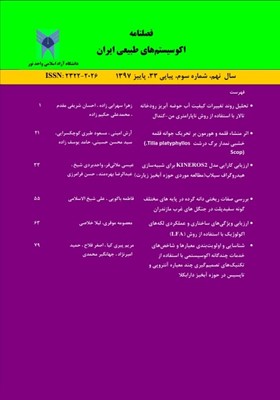بررسی صفات ریختی دانه گرده در پایه های مختلف گونه سفیدپلت در جنگل های غرب مازندران (مطالعه موردی: مرزن آباد و پارک جنگلی نور)
محورهای موضوعی : بذر و نهالعلی شیخ الاسلامی 1 * , فاطمه باکویی 2
1 - گروه جنگلداری، دانشگاه ازاد اسلامی واحد چالوس، چالوس، ایران.
2 - گروه جنگلداری، دانشگاه ازاد اسلامی واحد چالوس، چالوس، ایران.
کلید واژه: صفات ریختی دانه گرده, سفید پلت, مرزن آباد, پارک جنگلی نور,
چکیده مقاله :
گونه در معرض انقراض سفید پلت از گونه شاخص و اندمیک در جنگلهای هیرکانی میباشد که متاسفانه به علت عدم مدیریت و حفاظت مناسب در حال انقراض میباشد. گونه سفیدپلت جزء ذخایر ژنتیکی ارزشمند جنگلهای هیرکانی بوده ولی با وجود نادر بودن، بومی بودن، مختص بودن، در معرض تهدید بودن و نقش آن در حفظ سیمای طبیعی جنگلهای شمال، اطلاعات کمی از شرایط اکولوژیکی، مورفولوژیکی و فیزیولوژیکی این گونه وجود دارد، از انجا که حفظ تنوع ژنتیکی ضامن بقای گونه میباشد، مطالعات دانه گرده به عنوان یکی از نشانگرهای در مطالعات ژنتیکی در شناخت تنوع ژنتیکی گونه از اهمیت برخورداراست. در این تحقیق خصوصیات دانه گرده در جمعیتهای مختلف این گونه در جنگلهای مرزن آباد و پارک جنگلی نور بررسی گردید. خصوصیات کمی و کیفی دانههای گرده به وسیله میکروسکوپ نوری و الکترونی بررسی شد. نتایج نشان دهنده عدم اختلاف معنی دار در خصوصیات دانه گرده و نوع آن در جمعیتهای مختلف این گونه است.
The Populus Caspica is a critically endangered and endemic species in Hyrcanian forest which is unfortunately endangered due to lack of proper management and conservation. Populus Caspica stands as a genetically valuable component of Hyrcanian forest resources but considering its rarity, nativity, uniqueness, being threatened and its role in preserving the natural landscape of northern forests, little information is available for its ecological, morphological and physiological condition, therefore, based on the given facts, more research are required to be conducted in these fields. In this study, we tried to introduce the pollen characterization in different populations of this species in west Mazandaran forests (Marzanabad and Nour). Consequently, two natural habitats of this species in West Mazandaran forests were used. The quantitative and qualitative characteristics of pollen grains were studied by light (optical) and electron microscopes. The results showed that there was no significant difference in pollen characteristics and types in different populations of this species.
References
1- Asadi Farhad, Mirzaei Nadoushan Hossein , Mokhtari Jamshid, 2016, Comparison of vegetative behavior of whitefly progeny with mother trees, Forest and Products of Wood (Natural Resources of Iran), 69(4):713-723.
2- Erdtman, G. 1960. The acetolysis method. A revised description. Svensk Botanisk Tidskrift. 54: 561-564.
3- Fallah H., Tabari Kochaksaraei, M. and Azadfar D. 2011. Determination ecotypes of Populus caspica Bornm. in plain communities of Caspian forests using morphological markers of leaf and peroxidase isoenzymes. Taxonomy and Biosystematics, 3(6): 47-58.
4- Fallah H., Tabari Kochaksaraei, M., Azadfar D. and Babaie F., 2012. Investigation of genetic diversity in endangered stands of Populus caspica Bornm. of sub-mountain forests in north of Iran. Iranian Journal of Rangelands and Forests Plant Breeding and Genetic Research 19(2):289-303.
5- Fallahchai M.M.1, Salehi A.2 and Mardalizad Gh.3, 2016, Natural Regeneration of (Populus caspica Bornm.) and its relationship with soil physical and chemical properties (Case Study: Safrabaste Region in East of Guilan province), The Journal of Plant Research, 29(1):118-129.
6- Jalilvand, H., 1988. Investigation of Geographical Distribution and Ecological Condition of Populus caspica in Northern Forests of Iran. MSc Thesis, Natural resources and Agriculture faculty, University of Tarbiat Modares, 202p.
7- Miles, L. M., Jeanne, A. M. and Robert, D. W. 1995. Provenance and progeny variation in growth and frost tolerance of Casuarina Cunninghmiana in California, USA. Forest Ecology and Management. 79: 161-171.
8- Yousefzadeh H., M. Tabari, A. Hosseinzadeh Colagar, A. Sattarian and M. Assadi, ,2013, Flower and Pollen Morphology Variations in Tilia spp. Populations in Hyrcanain Forests, Journal of Natural Environment, Iranian Journal of Natural Resources, 65(4):497508.
_||_References
1- Asadi Farhad, Mirzaei Nadoushan Hossein , Mokhtari Jamshid, 2016, Comparison of vegetative behavior of whitefly progeny with mother trees, Forest and Products of Wood (Natural Resources of Iran), 69(4):713-723.
2- Erdtman, G. 1960. The acetolysis method. A revised description. Svensk Botanisk Tidskrift. 54: 561-564.
3- Fallah H., Tabari Kochaksaraei, M. and Azadfar D. 2011. Determination ecotypes of Populus caspica Bornm. in plain communities of Caspian forests using morphological markers of leaf and peroxidase isoenzymes. Taxonomy and Biosystematics, 3(6): 47-58.
4- Fallah H., Tabari Kochaksaraei, M., Azadfar D. and Babaie F., 2012. Investigation of genetic diversity in endangered stands of Populus caspica Bornm. of sub-mountain forests in north of Iran. Iranian Journal of Rangelands and Forests Plant Breeding and Genetic Research 19(2):289-303.
5- Fallahchai M.M.1, Salehi A.2 and Mardalizad Gh.3, 2016, Natural Regeneration of (Populus caspica Bornm.) and its relationship with soil physical and chemical properties (Case Study: Safrabaste Region in East of Guilan province), The Journal of Plant Research, 29(1):118-129.
6- Jalilvand, H., 1988. Investigation of Geographical Distribution and Ecological Condition of Populus caspica in Northern Forests of Iran. MSc Thesis, Natural resources and Agriculture faculty, University of Tarbiat Modares, 202p.
7- Miles, L. M., Jeanne, A. M. and Robert, D. W. 1995. Provenance and progeny variation in growth and frost tolerance of Casuarina Cunninghmiana in California, USA. Forest Ecology and Management. 79: 161-171.
8- Yousefzadeh H., M. Tabari, A. Hosseinzadeh Colagar, A. Sattarian and M. Assadi, ,2013, Flower and Pollen Morphology Variations in Tilia spp. Populations in Hyrcanain Forests, Journal of Natural Environment, Iranian Journal of Natural Resources, 65(4):497508.

